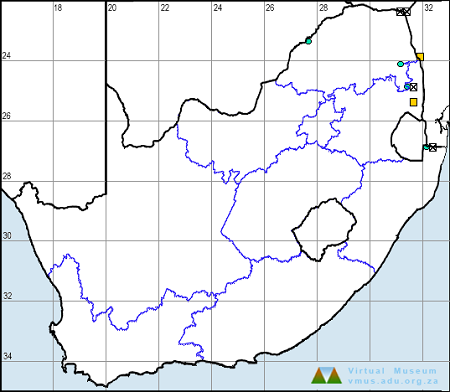Cover photo by Bart Wursten.
Find the Zambezi Siphontail in the FBIS database (Freshwater Biodiversity Information System) here.
Family Gomphidae
Identification

Zambezi National Park, Zimbabwe
Photo by Bart Wursten
Large size
Length attains 57mm; Wingspan up to 73mm.
The Zambezi Siphontail is strikingly marked in lime-green and brown. The thorax is green with narrow brown lines on the top and sides. The abdomen is mostly brown with yellow-green ‘triangular’ markings down the sides. There is a diagnostic yellow band around the eighth segment on the abdomen. The males have modest foliations on segments eight and nine.
Females resemble the males but have reduced foliations on the abdomen and are more robust.
The Zambezi Siphontail is most similar to Phyllogomphus selysi (Bold Leaftail), but that species is noticeably larger and darker in appearance, with thicker black markings and larger foliations on the abdomen.
Click here for more details on identification of the Zambezi Siphontail.
Habitat
The natural habitat of the Zambezi Siphontail is subtropical or tropical lowland savannas, where it inhabits the fringes of larger rivers. It favours rivers with well-wooded banks.

Photo by Ryan Tippett
Behaviour
The Zambezi Siphontail hunts from a perch and has a relatively slow, weak flight. Hunting is done from bushes and other low vegetation. The Zambezi Siphontail is often found some distance from the water.
Status and Conservation
The Zambezi Siphontail is a rare species in South Africa. It is listed as Vulnerable in the IUCN Red List of Threatened Species.
Distribution
Neurogomphus zambeziensis is found over a relatively small area of south-eastern Africa where it has been recorded in Botswana, Mozambique, Namibia, South Africa, Zambia, Zimbabwe, and possibly Tanzania.
In South Africa it occurs marginally along larger, east-flowing rivers in Limpopo, Mpumalanga and extreme northern KwaZulu-Natal.
Below is a map showing the distribution of records for Zambezi Siphontail in the OdonataMAP database as at February 2020.

Below is a map showing the distribution of records for Zambezi Siphontail in the OdonataMAP database as of December 2024.

The next map below is an imputed map, produced by an interpolation algorithm, which attempts to generate a full distribution map from the partial information in the map above. This map will be improved by the submission of records to the OdonataMAP section of the Virtual Museum.


Ultimately, we will produce a series of maps for all the odonata species in the region. The current algorithm is a new algorithm. The objective is mainly to produce “smoothed” maps that could go into a field guide for odonata. This basic version of the algorithm (as mapped above) does not make use of “explanatory variables” (e.g. altitude, terrain roughness, presence of freshwater — we will be producing maps that take these variables into account soon). Currently, it only makes use of the OdonataMAP records for the species being mapped, as well as all the other records of all other species. The basic maps are “optimistic” and will generally show ranges to be larger than what they probably are.
These maps use the data in the OdonataMAP section of the Virtual Museum, and also the database assembled by the previous JRS funded project, which was led by Professor Michael Samways and Dr KD Dijkstra.
Phenology

Further Resources
The use of photographs by Bart Wursten is acknowledged.
Zambezi Siphontail Neurogomphus zambeziensis Cammaerts, 2004
Other Common Names: Zambezihewelstert (Afrikaans).
Recommended citation format: Loftie-Eaton M; Navarro R; Tippett RM; Underhill L. 2025. Zambezi Siphontail Neurogomphus zambeziensis. Biodiversity and Development Institute. Available online at https://thebdi.org/2020/05/11/zambezi-siphontail-neurogomphus-zambeziensis/
References: Tarboton, M; Tarboton, W. (2019). A Guide to the Dragonflies & Damselflies of South Africa. Struik Nature.
Samways, MJ. (2008). Dragonflies and Damselflies of South Africa. Pensoft
Samways, MJ. (2016). Manual of Freshwater Assessment for South Africa: Dragonfly Biotic Index. Suricata 2. South African National Biodiversity Institute, Pretoria
Martens, A; Suhling, F. (2007). Dragonflies and Damselflies of Namibia. Gamsberg Macmillan.

